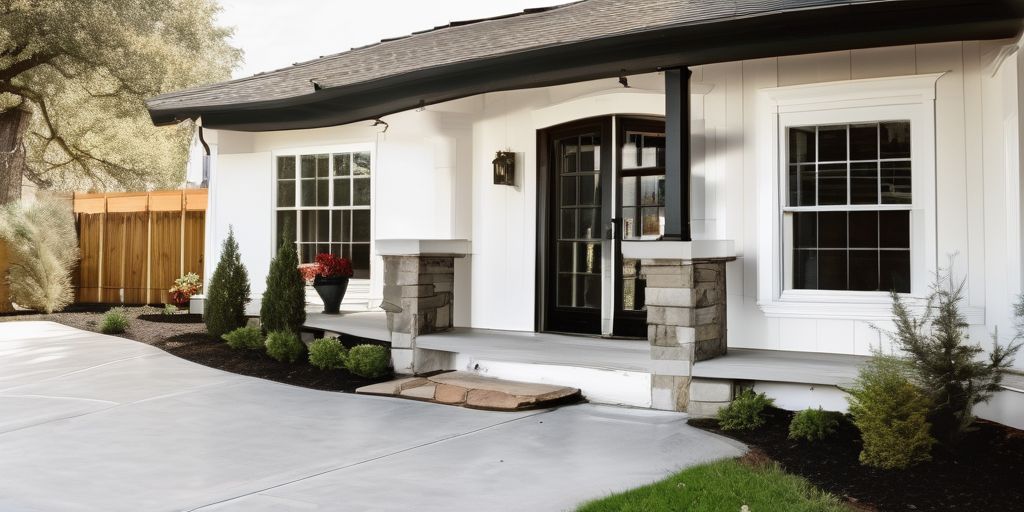Pre-paint treatments are crucial for ensuring the longevity and aesthetic appeal of aluminum siding. Proper preparation, including cleaning, priming, and sealing, can significantly enhance the durability and appearance of the paint job. This article provides a comprehensive guide on the essential steps and products needed for effective pre-paint treatments on aluminum siding.
Key Takeaways
- Choosing the right non-abrasive cleanser is essential for removing dirt, grime, and oxidation without damaging the aluminum siding.
- Applying a high-quality primer ensures that paint adheres properly and adds an extra layer of protection against the elements.
- Proper preparation, including cleaning and repairing any damage, is crucial for the longevity of aluminum siding.
- High-quality acrylic paints are recommended for their durability and wide range of color options.
- Using a high-quality exterior caulk as a sealant prevents moisture from penetrating and causing further damage.
Understanding the Importance of Pre-Paint Treatments
Pre-paint treatments are crucial for ensuring a long-lasting and aesthetically pleasing finish on your aluminum siding. Proper preparation can make a significant difference in the durability and appearance of your paint job. Let’s delve into why these treatments matter, the benefits of proper preparation, and common mistakes to avoid.
Why Pre-Paint Treatments Matter
Pre-paint treatments are essential for several reasons:
- They help the paint adhere better to the surface.
- They provide a smooth and even base for the paint.
- They protect the underlying material from moisture and other environmental factors.
Skipping these steps can lead to subpar results and may require more frequent touch-ups. Taking the time to properly prepare the siding will pay off in the appearance and longevity of your restoration efforts.
Benefits of Proper Preparation
Proper preparation offers numerous benefits:
- Enhanced Durability: Well-prepared surfaces are less likely to peel or chip.
- Improved Aesthetics: A smooth base ensures a more professional finish.
- Long-term Protection: Pre-paint treatments can protect against moisture and UV damage.
Common Mistakes to Avoid
Avoid these common mistakes to ensure the best results:
- Skipping the cleaning step.
- Using the wrong type of primer.
- Not allowing enough drying time between coats.
Remember, skipping any of these steps can lead to subpar results and may require more frequent touch-ups. Taking the time to properly prepare the siding will pay off in the appearance and longevity of your restoration efforts.
Choosing the Right Cleanser for Aluminum Siding
Types of Non-Abrasive Cleansers
When it comes to cleaning aluminum siding, choosing the right cleanser is crucial. A variety of cleansers are available, designed to remove dirt, grime, and oxidation without damaging the aluminum. It’s important to choose a non-abrasive cleanser that is effective yet gentle on the metal. Here are some common types:
- Mild Detergents: These are great for regular cleaning and removing light dirt and grime.
- Specialized Aluminum Cleaners: Formulated specifically for aluminum, these cleaners tackle oxidation and tougher stains.
- Bleach Solutions: Useful for removing mold and mildew, but should be used with caution.
How to Effectively Clean Aluminum Siding
Begin with thorough cleaning and prepping of the aluminum siding to ensure that the surface is free of contaminants that could interfere with adhesion. Follow these steps for effective cleaning:
- Power Wash: Use a power washer with the correct detergent to rid the surface of chalk, oil, and other foreign materials.
- Test for Mold: Apply a few drops of household bleach to dark spots. If they bleach away, they’re probably mildew. Use a solution of one part bleach to three parts water to eliminate the rest.
- Rinse Thoroughly: Ensure all cleaning agents are completely rinsed off to avoid any residue.
Proper preparation and maintenance are essential for the longevity of the siding. This includes regular cleaning, repairing any damage, and applying the right type of primer before any restoration work.
Safety Tips for Using Cleansers
Safety should always be a priority when using any type of cleanser. Here are some tips to keep in mind:
- Wear Protective Gear: Gloves and safety goggles can protect your skin and eyes from harsh chemicals.
- Ventilation: Ensure the area is well-ventilated to avoid inhaling fumes.
- Follow Instructions: Always read and follow the manufacturer’s instructions on the cleanser’s label.
- Test First: Before applying a cleanser to the entire surface, test it on a small, inconspicuous area to ensure it doesn’t cause any damage.
By following these guidelines, you can ensure that your aluminum siding is clean and ready for the next steps in your painting project.
Selecting the Best Primer for Aluminum Siding
Types of Primers Suitable for Aluminum
Choosing the right primer is crucial for ensuring that any paint or coating adheres properly to the aluminum siding. Primers also provide an additional layer of protection against elements. Here are some types of primers suitable for aluminum:
- Alkyd Primers: These are oil-based and provide excellent adhesion and durability.
- Acrylic Primers: Water-based and known for their quick drying time and flexibility.
- Bonding Primers: Specifically designed to adhere to slick surfaces, making them ideal for aluminum siding.
Application Techniques for Primers
Applying primer correctly is essential for a smooth and long-lasting finish. Follow these steps to ensure proper application:
- Clean the Surface: Make sure the aluminum siding is clean and free of dirt, grime, and oxidation.
- Repair Any Damage: Fix any dents or pitted areas before priming.
- Apply the Primer: Use a brush, roller, or sprayer to apply an even coat of primer. Ensure that the primer is compatible with the topcoat you will be using.
- Allow to Dry: Let the primer dry completely before applying the topcoat.
Common Issues and Solutions
Even with the best preparation, issues can arise. Here are some common problems and their solutions:
- Poor Adhesion: This can occur if the surface is not properly cleaned or if the wrong type of primer is used. Ensure the surface is clean and use a bonding primer if necessary.
- Bubbling or Blistering: This can happen if the primer is applied too thickly or if the surface is not completely dry. Apply thin, even coats and allow sufficient drying time.
- Chalking: Over time, some primers can break down and form a chalky residue. Regular maintenance and reapplication can prevent this.
Proper preparation and maintenance are essential for the longevity of the siding. This includes regular cleaning, repairing any damage, and applying the right type of primer before any restoration work, such as painting.
Applying Sealants to Protect Your Aluminum Siding
Applying sealants to your aluminum siding is a crucial step in ensuring its longevity and durability. Sealants provide an additional layer of protection against the elements, preventing moisture from penetrating and causing further damage. Here’s a guide to help you understand the different types of sealants, how to apply them correctly, and how to maintain your sealed aluminum siding.
Types of Sealants
Choosing the right sealant is essential for effective protection. Here are some common types:
- Silicone Sealants: Ideal for flexibility and durability.
- Polyurethane Sealants: Known for their strong adhesion and resistance to weathering.
- Acrylic Sealants: Easy to apply and paintable, but less flexible.
How to Apply Sealants Correctly
Proper application of sealants ensures maximum protection. Follow these steps:
- Clean the Surface: Thoroughly clean the siding to remove any dirt, debris, or oxidation. This ensures that the sealant adheres properly.
- Choose the Right Sealant: Select a sealant that suits your needs, whether it’s silicone, polyurethane, or acrylic.
- Apply the Sealant: Use a caulking gun to apply the sealant evenly along the seams and any gaps or cracks. Smooth the sealant with a tool or your finger for a neat finish.
- Allow to Cure: Let the sealant cure as per the manufacturer’s instructions before exposing it to moisture.
Proper preparation and maintenance are essential for the longevity of the siding. This includes regular cleaning, repairing any damage, and applying the right type of primer before any restoration work, such as painting.
Maintaining Sealed Aluminum Siding
Maintaining your sealed aluminum siding is key to its long-term performance. Here are some tips:
- Regular Inspections: Check for any signs of wear or damage, especially after severe weather.
- Routine Cleaning: Clean the siding periodically to remove dirt and prevent buildup that can degrade the sealant.
- Reapply Sealant as Needed: Over time, sealants can wear out. Reapply sealant to any areas showing signs of deterioration.
By following these steps, you can ensure that your aluminum siding remains protected and looks great for years to come.
Painting Aluminum Siding: Tips and Tricks
Painting aluminum siding can be a rewarding project that refreshes the look of your home. Here are some tips and tricks to help you achieve a professional finish.
Choosing the Right Paint
Selecting the appropriate paint is crucial for a long-lasting finish. High-quality acrylic paints are recommended for aluminum siding due to their durability and wide range of colors. Make sure to choose a paint that is specifically formulated for exterior use to withstand the elements.
Application Methods for a Smooth Finish
To achieve a smooth finish, follow these steps:
- Clean the siding thoroughly with a soapy solution and rinse it with clean water. If you don’t have a pressure washer, thoroughly hose down the siding.
- Apply a primer suitable for aluminum siding to ensure proper adhesion of the paint.
- Use a high-quality brush or roller to apply the paint evenly. For larger areas, consider using a paint sprayer for a more uniform finish.
- Paint during the early part of the day, before the sun begins to shine on the siding, to avoid quick drying and uneven application.
Common Painting Problems and Fixes
Even with the best preparation, issues can arise. Here are some common problems and their solutions:
- Blistering: This can occur if the paint is applied in direct sunlight or on a hot surface. To avoid this, paint in the early morning or late afternoon.
- Peeling: Often caused by poor surface preparation. Ensure the siding is clean and dry before painting.
- Streaking: This can happen if the paint is too thick or if it’s applied unevenly. Use even strokes and avoid overloading the brush or roller.
Remember, proper preparation and maintenance are essential for the longevity of your aluminum siding. Regular cleaning, repairing any damage, and applying the right type of primer before painting can make a significant difference.
By following these tips and tricks, you can achieve a professional-looking finish that will enhance the curb appeal of your home.
Maintaining Your Aluminum Siding Post-Paint
Maintaining your aluminum siding after painting is crucial for preserving its appearance and longevity. Proper preparation and maintenance are essential for the longevity of the siding. This includes regular cleaning, repairing any damage, and applying the right type of primer before any restoration work, such as painting. Painting aluminum siding is a cost-effective way to refresh your home’s exterior, offering environmental benefits and aesthetic flexibility.
Routine Cleaning and Upkeep
Regular cleaning is vital to keep your aluminum siding looking fresh and new. Here are some steps to follow:
- Pressure wash: Clean off all dirt, mildew, and debris. Allow the surface to dry completely before proceeding.
- Use a mild detergent: Mix with water to create a gentle cleaning solution.
- Soft brush or cloth: Use these to scrub the siding gently.
- Rinse thoroughly: Ensure all soap residue is removed to prevent streaking.
Inspecting for Damage
Regular inspections can help you catch and repair damage early, preventing more extensive issues down the line. Look for:
- Cracks or dents: These can allow moisture to penetrate and cause further damage.
- Peeling paint: Indicates that the paint is no longer adhering properly and may need to be reapplied.
- Mold or mildew: Can be treated with a bleach solution (one part bleach to three parts water).
When to Reapply Sealants and Paint
Reapplying sealants and paint at the right time is crucial for maintaining the protective layer on your aluminum siding. Here are some guidelines:
- Every 3-5 years: It’s recommended to restore sheen and protection every 3-5 years.
- Choose durable paint: Ensure the paint is compatible with aluminum and offers long-lasting protection.
- Regular maintenance: Regular cleaning and inspections can greatly extend the life of the restoration.
Remember, maintaining your aluminum siding is not just about aesthetics; it’s also about protecting your home from the elements.
Repairing Damaged Aluminum Siding
Identifying Common Types of Damage
Before the restoration process can begin, it’s crucial to address any damage on the aluminum siding. Start by inspecting the siding for dents, scratches, or corrosion. These imperfections can compromise the final result if not dealt with properly.
Step-by-Step Repair Guide
- Inspect the Siding: Look for any visible damage such as holes, dents, or scratches.
- Clean the Area: Remove any dirt or debris from the damaged area.
- Fill Dents and Holes: Use a suitable filler to repair dents and holes. Sand the area smooth once the filler is dry.
- Prime the Repaired Area: Apply a primer to ensure the paint adheres properly.
- Paint the Siding: Use a paint that is compatible with aluminum siding for the best results.
Seasonal maintenance is key to prolonging the life of aluminum siding. Regular checks for damage and prompt repairs can prevent small issues from becoming major problems.
Preventing Future Damage
Proper preparation and maintenance are essential for the longevity of the siding. This includes regular cleaning, repairing any damage, and applying the right type of primer before any restoration work, such as painting. Painting aluminum siding is a cost-effective way to refresh your home’s exterior, offering environmental benefits and aesthetic flexibility.
Repairing damaged aluminum siding can be a daunting task, but with the right expertise, it can be done efficiently and effectively. At We Paint Siding, we specialize in bringing old, faded aluminum siding back to life with our professional painting services. Don’t let damaged siding detract from your home’s curb appeal. Visit our website to learn more about our services and get a free estimate today!
Conclusion
In conclusion, proper pre-paint treatments such as cleaning, priming, and sealing are essential for maintaining the longevity and appearance of aluminum siding. Using non-abrasive cleansers to remove dirt and oxidation, applying high-quality primers to ensure paint adhesion, and sealing gaps with exterior caulk are all crucial steps. These practices not only enhance the aesthetic appeal of your home but also provide an additional layer of protection against the elements. By following these guidelines, you can achieve a durable and beautiful finish that will stand the test of time. Happy painting!
Frequently Asked Questions
Is it necessary to prime aluminum siding before painting?
No, as long as the siding has had a chance to weather for a year before painting. However, you do need to clean the surfaces first with an extra strength cleaner degreaser to ensure they are free of chalk and residue.
What types of cleansers are suitable for aluminum siding?
A variety of non-abrasive cleansers are available, designed to remove dirt, grime, and oxidation without damaging the aluminum. It’s important to choose a cleanser that is effective yet gentle on the metal.
What type of paint is recommended for aluminum siding?
High-quality acrylic paints are recommended for aluminum siding. They offer durability and a wide range of colors to choose from.
How should aluminum siding be prepared prior to painting?
Begin with thorough cleaning and prepping of the aluminum siding to ensure that the surface is free of contaminants that could interfere with adhesion. Use power washing and sanding techniques to create a smooth substrate for the new coating.
How do I apply sealants correctly to aluminum siding?
To seal any gaps or cracks, use a high-quality exterior caulk. Make sure the surface is clean and dry before application. Apply the sealant evenly and smooth it out to ensure proper adhesion and protection against moisture.
When should I reapply sealants and paint on aluminum siding?
Regular maintenance is key. Inspect your siding annually for any signs of damage or wear. Reapply sealants and paint as needed to ensure ongoing protection and aesthetic appeal.





